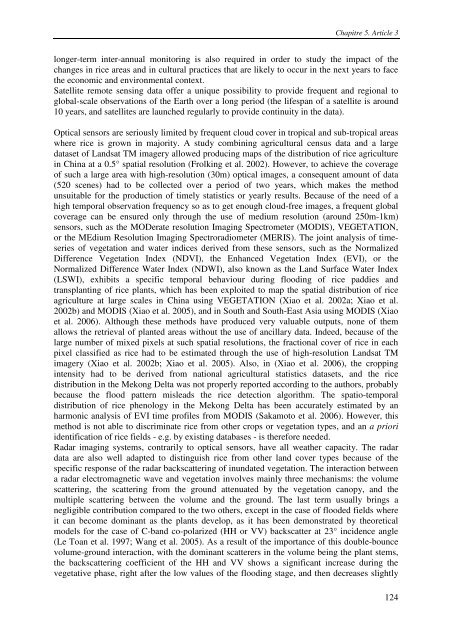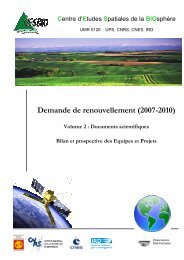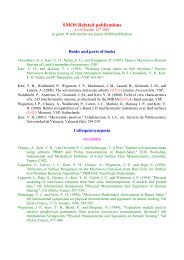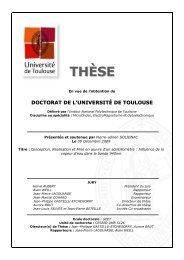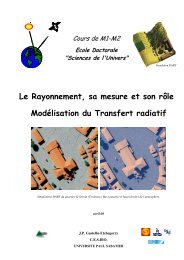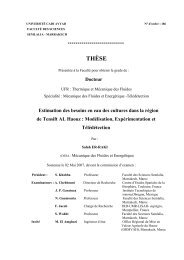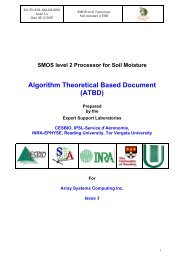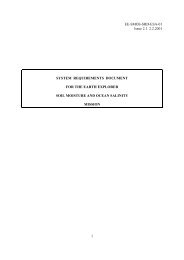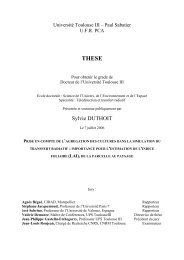THÃS EE - CESBIO - Université Toulouse III - Paul Sabatier
THÃS EE - CESBIO - Université Toulouse III - Paul Sabatier
THÃS EE - CESBIO - Université Toulouse III - Paul Sabatier
You also want an ePaper? Increase the reach of your titles
YUMPU automatically turns print PDFs into web optimized ePapers that Google loves.
Chapitre 5. Article 3longer-term inter-annual monitoring is also required in order to study the impact of thechanges in rice areas and in cultural practices that are likely to occur in the next years to facethe economic and environmental context.Satellite remote sensing data offer a unique possibility to provide frequent and regional toglobal-scale observations of the Earth over a long period (the lifespan of a satellite is around10 years, and satellites are launched regularly to provide continuity in the data).Optical sensors are seriously limited by frequent cloud cover in tropical and sub-tropical areaswhere rice is grown in majority. A study combining agricultural census data and a largedataset of Landsat TM imagery allowed producing maps of the distribution of rice agriculturein China at a 0.5° spatial resolution (Frolking et al. 2002). However, to achieve the coverageof such a large area with high-resolution (30m) optical images, a consequent amount of data(520 scenes) had to be collected over a period of two years, which makes the methodunsuitable for the production of timely statistics or yearly results. Because of the need of ahigh temporal observation frequency so as to get enough cloud-free images, a frequent globalcoverage can be ensured only through the use of medium resolution (around 250m-1km)sensors, such as the MODerate resolution Imaging Spectrometer (MODIS), VEGETATION,or the MEdium Resolution Imaging Spectroradiometer (MERIS). The joint analysis of timeseriesof vegetation and water indices derived from these sensors, such as the NormalizedDifference Vegetation Index (NDVI), the Enhanced Vegetation Index (EVI), or theNormalized Difference Water Index (NDWI), also known as the Land Surface Water Index(LSWI), exhibits a specific temporal behaviour during flooding of rice paddies andtransplanting of rice plants, which has been exploited to map the spatial distribution of riceagriculture at large scales in China using VEGETATION (Xiao et al. 2002a; Xiao et al.2002b) and MODIS (Xiao et al. 2005), and in South and South-East Asia using MODIS (Xiaoet al. 2006). Although these methods have produced very valuable outputs, none of themallows the retrieval of planted areas without the use of ancillary data. Indeed, because of thelarge number of mixed pixels at such spatial resolutions, the fractional cover of rice in eachpixel classified as rice had to be estimated through the use of high-resolution Landsat TMimagery (Xiao et al. 2002b; Xiao et al. 2005). Also, in (Xiao et al. 2006), the croppingintensity had to be derived from national agricultural statistics datasets, and the ricedistribution in the Mekong Delta was not properly reported according to the authors, probablybecause the flood pattern misleads the rice detection algorithm. The spatio-temporaldistribution of rice phenology in the Mekong Delta has been accurately estimated by anharmonic analysis of EVI time profiles from MODIS (Sakamoto et al. 2006). However, thismethod is not able to discriminate rice from other crops or vegetation types, and an a prioriidentification of rice fields - e.g. by existing databases - is therefore needed.Radar imaging systems, contrarily to optical sensors, have all weather capacity. The radardata are also well adapted to distinguish rice from other land cover types because of thespecific response of the radar backscattering of inundated vegetation. The interaction betweena radar electromagnetic wave and vegetation involves mainly three mechanisms: the volumescattering, the scattering from the ground attenuated by the vegetation canopy, and themultiple scattering between the volume and the ground. The last term usually brings anegligible contribution compared to the two others, except in the case of flooded fields whereit can become dominant as the plants develop, as it has been demonstrated by theoreticalmodels for the case of C-band co-polarized (HH or VV) backscatter at 23° incidence angle(Le Toan et al. 1997; Wang et al. 2005). As a result of the importance of this double-bouncevolume-ground interaction, with the dominant scatterers in the volume being the plant stems,the backscattering coefficient of the HH and VV shows a significant increase during thevegetative phase, right after the low values of the flooding stage, and then decreases slightly124


